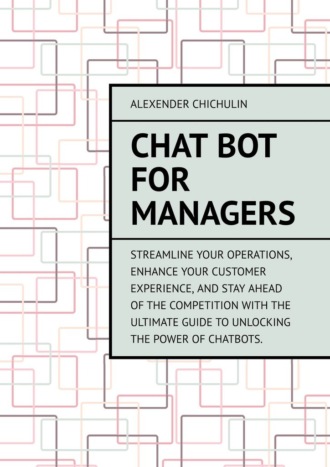
Alexender Chichulin
Chat bot for managers
© Alexender Chichulin, 2023
ISBN 978-5-0060-0518-1
Created with Ridero smart publishing system
1. Introduction
– Definition of chat bots and their benefits for managers
Chat bots are computer programs designed to simulate conversation with human users, usually through messaging or voice interfaces. They have become increasingly popular in recent years, particularly in customer service and sales, due to their ability to provide quick and efficient responses to queries and provide personalized assistance. However, chat bots can also be incredibly useful for managers, providing a range of benefits such as:
– Streamlining communication and improving response times
– Automating repetitive tasks and freeing up time for more strategic work
– Providing real-time data and analytics to inform decision-making
– Enhancing customer experience and satisfaction
– Reducing costs associated with hiring and training additional staff
In this section, we will explore these benefits in more detail and discuss how chat bots can help managers in various industries and functions.
– Overview of the guide and what readers can expect
This guide is designed to provide a comprehensive overview of chat bots for managers. It will cover everything from the basics of chat bots and their benefits for managers, to the process of planning, building, deploying, and maintaining a chat bot. The guide is written in a language that is easily understandable by all readers, regardless of their technical background.
The guide is divided into several sections, starting with an introduction to chat bots and their benefits for managers. We will then delve into the different types of chat bots, how they work, and their advantages and disadvantages. After that, we will explore the planning and building process, including how to identify your goals and objectives, choose the right platform and tools, design your chat bot conversation flow, and integrate it with other systems.
We will then move on to the training and deployment of your chat bot, covering topics such as testing, data collection and feedback, refining and improving your chat bot, and strategies for promoting it. We will also discuss how to measure success and ROI.
The guide also includes a section on maintaining and improving your chat bot, which covers monitoring and analyzing chat bot performance, making necessary updates and improvements, and scaling up your chat bot. We will also provide real-life case studies of successful chat bot implementations, as well as an exploration of emerging trends and potential future applications for chat bots.
By the end of this guide, readers should have a comprehensive understanding of chat bots and how they can be used to benefit managers. Whether you are new to chat bots or an experienced user, this guide will provide valuable insights and practical advice to help you make the most of this technology.
2. Understanding Chat Bots
– What are chat bots?
Chat bots are computer programs that are designed to simulate human conversation through messaging or voice interfaces. They are often used to automate customer service, sales, and support interactions, but they can also be used for a wide range of other purposes.
Chat bots use natural language processing (NLP) and artificial intelligence (AI) to understand and interpret user input, allowing them to respond with pre-programmed or customized answers. Some chat bots are designed to handle simple, repetitive tasks such as answering FAQs, while others are more advanced and can handle more complex interactions, such as booking appointments or conducting surveys.
There are various types of chat bots, including rule-based bots, which operate on a set of predefined rules, and AI-based bots, which use machine learning algorithms to learn and adapt to user interactions over time. Chat bots can be integrated with various messaging platforms, such as Vk, WhatsApp, and Slack, or they can be deployed as standalone applications.
Overall, chat bots are a powerful tool for automating tasks, improving customer service, and enhancing efficiency in a wide range of industries and functions.
– Types of chat bots
1. Rule-based chat bots: These bots operate on a set of predefined rules and are programmed to respond to specific keywords or phrases. They are often used for simple, straightforward tasks, such as answering frequently asked questions or providing basic customer service.
2. AI-based chat bots: These bots use natural language processing (NLP) and machine learning algorithms to understand and interpret user input, allowing them to provide more personalized and nuanced responses. AI-based chat bots can learn from past interactions and improve over time.
3. Task-oriented chat bots: These bots are designed to handle specific tasks or processes, such as booking a reservation, placing an order, or scheduling a meeting. They are often used in industries such as hospitality, e-commerce, and healthcare.
4. Virtual assistant chat bots: These bots are similar to task-oriented bots but are designed to provide more comprehensive support, such as managing email, setting reminders, or conducting research. They are often used for personal or business productivity.
5. Social chat bots: These bots are designed to interact with users on social media platforms, such as Vk, Vk, or Telegram. They can be used for various purposes, such as engaging with customers or conducting marketing campaigns.
6. Hybrid chat bots: These bots combine elements of both rule-based and AI-based chat bots, allowing them to handle both simple and complex interactions. Hybrid chat bots are often used in customer service or support contexts.
There are also industry-specific chat bots designed for sectors such as finance, healthcare, education, and more. Ultimately, the type of chat bot you choose will depend on your specific needs and goals.







